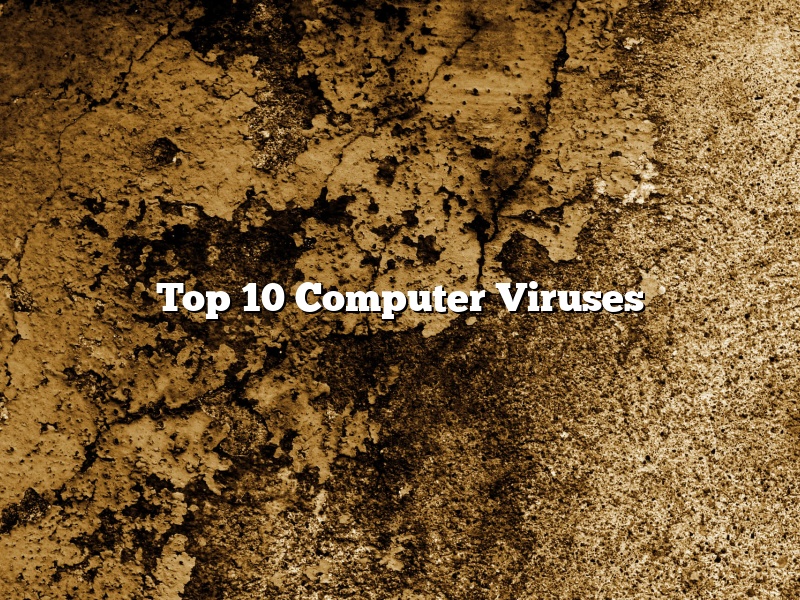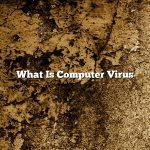Computer viruses are a type of malicious software that can infect a computer system without the user’s knowledge. Once a virus is installed, it can cause a range of problems, from displaying annoying pop-ups to damaging or deleting files.
There are many different types of computer viruses, but the most common ones are Trojans, worms, and ransomware. Trojans are malware that masquerade as legitimate programs, while worms are self-replicating programs that can spread quickly across a network. Ransomware is a type of malware that encrypts files on the infected computer and demands a ransom payment for the decryption key.
Here are the top 10 computer viruses that you need to be aware of:
1. Sality
Sality is a computer virus that first appeared in 2003. It is a Windows-specific virus that infects files with the .exe and .scr file extensions. Once infected, the virus will delete files, change the desktop wallpaper, and add new registry entries.
2. Conficker
Conficker is a worm that first appeared in 2008. It is a network worm that can infect Windows systems via removable drives, networks, and shares. It can also spread through email and instant messaging. The worm can disable security features, delete files, and download more malware.
3. Mydoom
Mydoom is a worm that first appeared in 2004. It is a mass-mailing worm that can spread through email, instant messaging, and file sharing networks. The worm can also disable antivirus programs and download more malware.
4. Melissa
Melissa is a virus that was first discovered in 1999. It is a macro virus that infects Microsoft Word documents. When the document is opened, the virus will infect the computer’s email program and send itself to all of the user’s contacts.
5. BlackEnergy
BlackEnergy is a Trojan that was first discovered in 2007. It is a Windows Trojan that can be used to launch DDoS attacks, steal information, and ransomware.
6. ILOVEYOU
ILOVEYOU is a virus that was first discovered in 2000. It is a Windows worm that spreads through email. The worm will attach itself to an email message and send itself to the recipient’s contacts. If the recipient opens the message, the worm will infect their computer.
7. Stuxnet
Stuxnet is a worm that was first discovered in 2010. It is a Windows worm that was specifically designed to target industrial control systems. It can cause significant damage to these systems and can even be used to shut down entire factories.
8. CryptoLocker
CryptoLocker is a ransomware that was first discovered in 2013. It is a Windows ransomware that encrypts files on the infected computer and demands a ransom payment for the decryption key.
9. Zeus
Zeus is a Trojan that was first discovered in 2007. It is a Windows Trojan that is used to steal banking information and financial data.
10. DroidLocker
DroidLocker is a ransomware that was first discovered in 2013. It is a Android ransomware that encrypts files on the infected phone and demands a ransom payment for the decryption key.
Contents [hide]
What are the 10 types of computer viruses?
There are many different types of computer viruses, but here are ten of the most common:
1. Boot sector viruses: These viruses infect the boot sector of a disk, which is the first sector read by the computer when it starts up. This can make it difficult or impossible to start up the computer.
2. File infectors: These viruses infect executable files, which means that they can spread to other files when the infected file is executed.
3. Macro viruses: These viruses use macros, which are small programs that are usually embedded in documents, to spread.
4. Multipartite viruses: These viruses can infect both executable files and boot sectors.
5. Polymorphic viruses: These viruses change their appearance every time they spread, making them more difficult to detect.
6. Stealth viruses: These viruses are designed to hide from anti-virus software.
7. Trojan horses: These are programs that appear to be something else but actually do something harmful, such as stealing information or damaging files.
8. Worms: These are programs that replicate themselves and spread to other computers.
9. Spyware: This is a type of malware that collects information about users without their permission.
10. Adware: This is a type of malware that displays ads on the user’s computer.
What are 6 top viruses that you could get on your computer?
There are many different viruses that you could get on your computer. In this article, we will discuss six of the most common ones.
The first virus is the cold virus. This virus is very common and is usually spread through contact with saliva or mucus. It can cause a sore throat, a runny nose, and a fever.
Another common virus is the flu virus. This virus is also spread through contact with saliva or mucus. It can cause a fever, a headache, and body aches.
The third virus is the stomach virus. This virus is usually spread through contact with feces. It can cause nausea, vomiting, and diarrhea.
The fourth virus is the herpes virus. This virus is most commonly spread through contact with saliva or mucus. It can cause sores on the lips, the mouth, or the genitals.
The fifth virus is the HPV virus. This virus is most commonly spread through contact with saliva or mucus. It can cause genital warts or cancer.
The sixth virus is the AIDS virus. This virus is most commonly spread through contact with blood or semen. It can cause AIDS or death.
If you are concerned that you may have contracted a virus, it is important to see a doctor.
What is the scariest PC virus?
There are many viruses that can infect a computer, but some are more feared than others. The scariest PC virus is one that is highly contagious and can quickly spread to other computers. It can also cause a lot of damage, including deleting files, or even crashing the computer.
One such virus is known as the Chernobyl virus. Named after the infamous Soviet nuclear disaster, this virus was first discovered in 1993. It is a highly contagious, file-deleting virus that can quickly spread to other computers. It can also cause the computer to crash.
Another scary PC virus is the Sasser virus. This virus was first discovered in 2004 and can cause the computer to crash, as well as delete files. It is also highly contagious and can spread quickly to other computers.
Another dangerous PC virus is the Conficker virus. This virus was first discovered in 2008 and can infect the computer’s operating system, making it difficult to remove. It can also delete files and crash the computer.
So, what is the scariest PC virus? It is difficult to say, as there are many dangerous viruses out there. But, the Chernobyl virus, the Sasser virus, and the Conficker virus are all considered to be some of the scariest PC viruses around.
What are the 3 major computer viruses?
There are many computer viruses out there, but there are three that stand out as the most common and most dangerous. These are the Melissa virus, the ILOVEYOU virus, and the Conficker virus.
The Melissa virus was first detected in 1999 and was one of the first viruses to use email to spread. It was named after the person who created it, Melissa McFarland. The virus caused widespread damage, infecting over a million computers and costing an estimated $80 million in damages.
The ILOVEYOU virus was also created in 1999 and is considered to be one of the most devastating viruses ever. It was spread through email and caused over $10 billion in damages.
The Conficker virus was first detected in 2008 and is still causing problems today. It is a worm that infects computers and creates a botnet that can be used to carry out cyber attacks. The Conficker virus has infected over 10 million computers and caused over $9 billion in damages.
These are just a few of the many computer viruses that have caused damage over the years. It is important to be aware of these viruses and to take steps to protect your computer from them.
What are the 20 computer viruses?
What are the 20 computer viruses?
There are many computer viruses that are known to exist. The following is a list of the 20 most common computer viruses:
1. The Melissa Virus
2. The I Love You Virus
3. The SirCam Virus
4. The CodeRed Worm
5. The Love Bug Virus
6. The Klez Virus
7. The Nimda Worm
8. The Sircam Worm
9. The MyDoom Worm
10. The BlackWorm Virus
11. The Slapper Worm
12. The BugBear Worm
13. The MSBlaster Worm
14. The Sobig Worm
15. The Agobot Worm
16. The Phising Worm
17. The Red Worm
18. The Yellow Worm
19. The White Worm
20. The AOL Time Warner Virus
Is logic bomb a virus?
Is Logic Bomb a Virus?
A logic bomb is a piece of code that is inserted into a software program with the intention of causing damage or harm. The code is designed to execute a certain action or set of actions when a specific condition is met. It is often referred to as a virus, but this is not technically accurate.
A logic bomb is not technically a virus because it does not replicate or self-propagate. It is a piece of code that is inserted manually into a software program. However, it can have just as devastating an effect as a virus.
A logic bomb can be used to destroy data, cripple a computer system, or even steal information. It is a very dangerous tool and should be avoided at all costs.
What does the ILOVEYOU virus do?
What does the ILOVEYOU virus do?
The ILOVEYOU virus is a computer virus that was first discovered in May of 2000. The virus is believed to have been created by a group of Filipino computer hackers. The virus is believed to have been sent as an email attachment with the subject line “ILOVEYOU”. When the recipient opened the attachment, the virus would infect their computer and send copies of itself to all of the recipient’s contacts.
The ILOVEYOU virus caused widespread damage and infecting millions of computers around the world. The virus was able to spread so quickly because it was able to exploit a vulnerability in the Microsoft Outlook email client. The virus was able to automatically send itself to all of the recipient’s contacts, without the recipient even opening the email.
The ILOVEYOU virus was able to cause massive damage because it was able to delete files and folders on the victim’s computer. The virus was also able to overwrite files with the text “ILOVEYOU”. The virus was also able to corrupt files and make them unusable.
The ILOVEYOU virus was also able to steal information from the victim’s computer. The virus was able to steal passwords and other sensitive information from the victim’s computer.
The ILOVEYOU virus was finally stopped when a computer security expert was able to create a vaccine that could protect computers from the virus.




